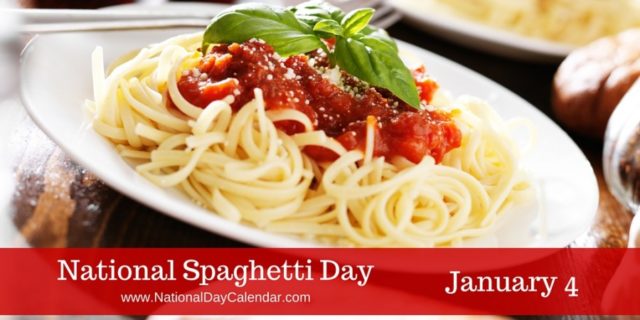
Pick your sauce! National Spaghetti Day on January 4 recognizes that long, thin cylindrical pasta of Italian and Sicilian origin. Usually made from semolina flour, this pasta has been a worldwide favorite for ages and loved by millions.
The word spaghetti is plural for the Italian word spaghetto, which is a diminutive of spago, meaning “thin string” or “twine.”
American restaurants offered Spaghetti around the end of the 19th century as Spaghetti Italienne (which is believed to have consisted of noodles cooked past al dente and a mild tomato sauce flavored with easily found spices and vegetables such as cloves, bay leaves and garlic). Decades later, oregano and basil were added to many recipes.
There is significant debate on the origin of spaghetti. However, we do know that pasta has been consumed for many, many years. There are records in the Jerusalem Talmud of itrium, a kind of boiled dough, commonly available in Palestine from the 3rd to 5th centuries AD. A 9th-century Arab dictionary describes itriyyaas as string-like shapes made of semolina and dried before cooking. In an 1154 writing for the Norman King of Sicily, itriyya is mentioned being manufactured and exported from Norman Sicily. Dried pasta became popular in the 14th and 15th centuries due to its easy storage. People were able to store the dried pasta in ships when exploring the New World. A century later, pasta was present around the globe during the voyages of discovery. (Wikipedia)
In March of 2009, the world record for the largest bowl of spaghetti was set and then reset in March of 2010 when a Garden Grove California Buca di Beppo restaurant successfully filled a swimming pool with more than 13,780 pounds of pasta.
- Italians never use a spoon and a fork when eating spaghetti. This is an American habit. In Italy you simply twirl a fork against the dish.
- Thin spaghetti served with tomato sauce dates only as far back as the 19th century, to Naples, Italy. In Naples the sauce was served with fatty meats like bacon, ham or sausage. Meatballs made with beef as an accompaniment to spaghetti started showing up in American cookbooks around World War II.
- In the year 2000, over 1.3 million pounds of spaghetti were sold in American grocery stores. If all of those packages were lined up, they could circle the Earth nine times.
- April 1 in 1957, the BBC made everyone believe that spaghetti grows on trees. At the time, spaghetti was considered by many as an exotic delicacy. The spoof program explained how severe frost can impair the flavor of the spaghetti and how each strand of spaghetti always grows to the same length. This is believed to be one of the first times television was used to stage an April Fools Day hoax.
- The average person in Italy eats more than 51 pounds of pasta every year.
- As you’d expect, Italy is the country that eats the greatest amount of pasta worldwide. As you might not expect, however, the number 2 and number 3 countries that eat the most pasta are Venezuela and Tunisia.
- According to the International Pasta Organization, there are more more than 600 different shapes of pasta produced throughout the world.
- Thomas Jefferson, the third president of the United States, is credited with being the first person to introduce pasta to America, back in 1789.
- One of the most important times in the history of the spaghetti was World War II. It was then that American soldiers came in close contact with European cuisine, bringing home tales about spaghetti and demanding its presence on the American market.
- Pasta was first made in China, not Italy. Shocked, right? While pasta is pretty much synonymous with Italian cuisine, in fact the first recorded reports of pasta being eaten actually come from China. Those reports go all the way back to 5,000 BC. In fact, legend says that Marco Polo, the famous Venetian explorer, actually introduced noodles to Italy some time in the 12th century. However, historical records show that pasta was already eaten in Italy by 500 BC. Still, that’s 4500 years after China.
https://youtu.be/JGBE3eLpvm0
Sources:
YouTube/Vintage Nursery Rhymes












